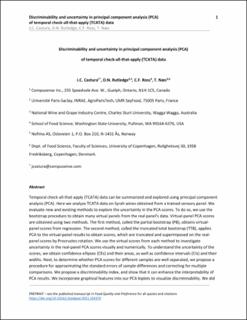| dc.contributor.author | Castura, J.C. | |
| dc.contributor.author | Rutledge, D.N. | |
| dc.contributor.author | Ross, C.F. | |
| dc.contributor.author | Næs, Tormod | |
| dc.date.accessioned | 2022-11-28T10:17:39Z | |
| dc.date.available | 2022-11-28T10:17:39Z | |
| dc.date.created | 2022-05-06T09:49:31Z | |
| dc.date.issued | 2022 | |
| dc.identifier.citation | Food Quality and Preference. 2022, 96 . | en_US |
| dc.identifier.issn | 0950-3293 | |
| dc.identifier.uri | https://hdl.handle.net/11250/3034418 | |
| dc.description.abstract | Temporal check-all-that-apply (TCATA) data can be summarized and explored using principal component analysis (PCA). Here we analyze TCATA data on Syrah wines obtained from a trained sensory panel. We evaluate new and existing methods to explore the uncertainty in the PCA scores. To do so, we use the bootstrap procedure to obtain many virtual panels from the real panel’s data. Virtual-panel PCA scores are obtained using two methods. The first method, called the partial bootstrap (PB), obtains virtual-panel scores from regression. The second method, called the truncated total bootstrap (TTB), applies PCA to the virtual-panel results to obtain scores, which are truncated and superimposed on the real-panel scores by Procrustes rotation. We use the virtual scores from each method to investigate uncertainty in the real-panel PCA scores visually and numerically. To understand the uncertainty of the scores, we obtain confidence ellipses (CEs) and their areas, as well as confidence intervals (CIs) and their widths. Next, to determine whether PCA scores for different samples are well separated, we propose a procedure for approximating the standard errors of sample differences and correcting for multiple comparisons. We propose a discriminability index, and show that it can enhance the interpretability of PCA results. We incorporate graphical features into our PCA biplots to visualize discriminability. We did not find a large difference between the PB and TTB methods for understanding the uncertainty and discriminability in PCA scores. Although the TCATA data that we analyzed have a special structure, the methodological approaches presented here can be readily adapted to other applications of PCA. | |
| dc.language.iso | eng | en_US |
| dc.title | Discriminability and uncertainty in principal component analysis (PCA) of temporal check-all-that-apply (TCATA) data | en_US |
| dc.title.alternative | Discriminability and uncertainty in principal component analysis (PCA) of temporal check-all-that-apply (TCATA) data | en_US |
| dc.type | Journal article | en_US |
| dc.type | Peer reviewed | en_US |
| dc.description.version | submittedVersion | |
| dc.source.pagenumber | 11 | en_US |
| dc.source.volume | 96 | en_US |
| dc.source.journal | Food Quality and Preference | en_US |
| dc.identifier.doi | 10.1016/j.foodqual.2021.104370 | |
| dc.identifier.cristin | 2021992 | |
| dc.relation.project | Nofima AS: 202102 | |
| dc.relation.project | Nofima AS: 202103 | |
| dc.relation.project | Norges forskningsråd: 314111 | |
| dc.relation.project | Norges forskningsråd: 314318 | |
| cristin.ispublished | true | |
| cristin.fulltext | preprint | |
| cristin.qualitycode | 1 | |
